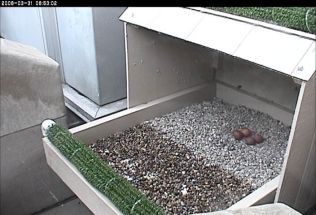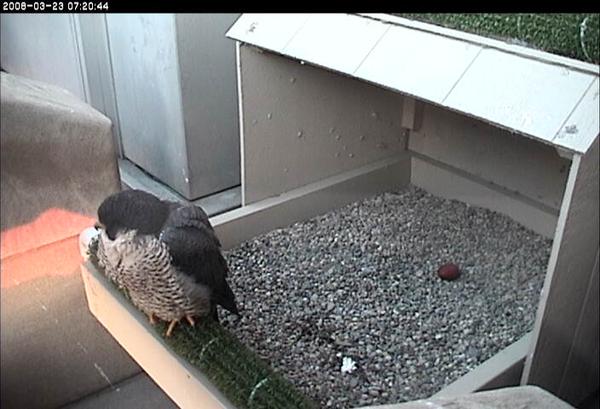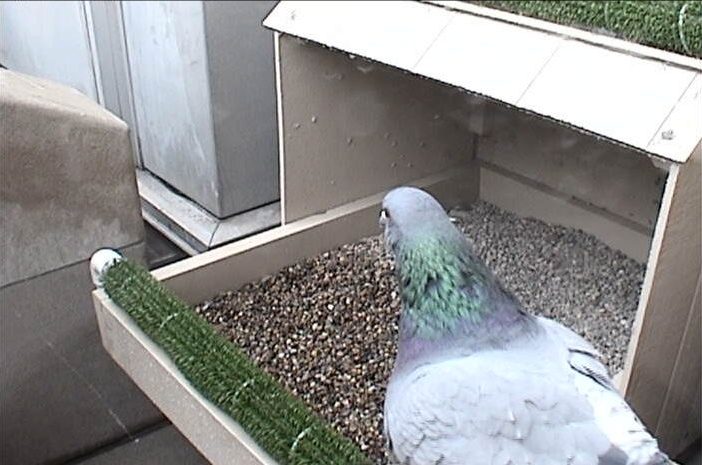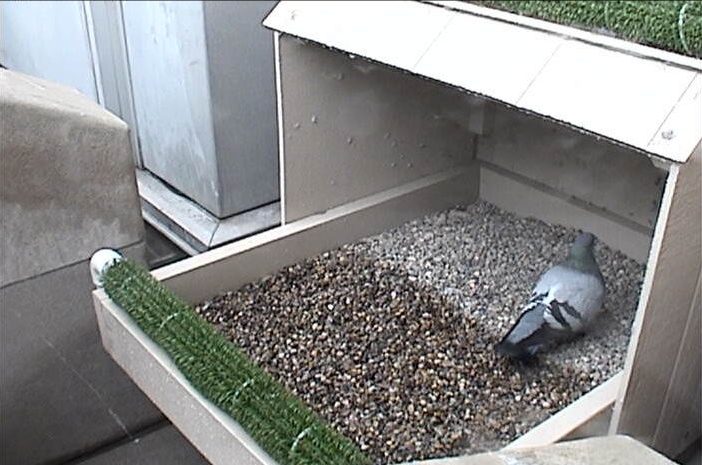 The peregrines in Beaver County settled a score today.
The peregrines in Beaver County settled a score today.
Last year Scott Gregg confirmed a peregrine nest at an Ohio River bridge in Monaca. This spring, not only are his peregrines at Monaca but a pair was seen mating at this railroad bridge in Beaver only 1.25 air-miles away.
Are there two peregrine nests in Beaver County? We met Scott Gregg at the railroad bridge this afternoon to find out.
At first there was no activity, then three peregrines chased each other from the bridge to the hillside. One was an immature bird, brown instead of gray. The adults made a show of strength by lowering their talons but there was no intense aggression.
After they flew away we decided to split up and monitor both bridges. Scott gave me a walkie-talkie and drove to Monaca while the rest of us stayed at the Beaver bridge.
As soon as he arrived at Monaca, Scott radioed that there was no activity whatsoever over there. Yet almost immediately in Beaver we saw three peregrines zoom past in a chase: an adult female and two immatures. It was hard to see the immature peregrines with the brown hillside as a backdrop but it was clear that the gloves had come off. This was a real fight.
The adult female chased the immature female and grabbed at her with her talons. The third bird flew with them, following every move. Under pursuit, the immature female flipped over to defend herself but the adult female grabbed her feet. Locked together they tumbled in a ball toward the river separating at the last minute before they hit the water. The adult female would not give up the chase, forcing the other two downriver in hot pursuit. After they disappeared from view an adult male peregrine flew off the railroad bridge and followed them. Four peregrines!
A little time passed and the adult female peregrine came back and landed on the tower of the railroad bridge. “She’s going to mate,” said my friend Karen. Quite a prediction!
In a few minutes the adult male peregrine returned from the chase and the pair copulated on the railroad bridge tower. Meanwhile, in Monaca Scott was bored. He saw no peregrines at all.
So what does this mean?
I think there’s only one peregrine nest in Beaver County – at the Monaca bridge. The Monaca pair sometimes mate on the Beaver railroad bridge as a way of claiming it as part of their territory. An immature female peregrine showed up and the pair did not drive her off because she looked too young to nest, but when a fourth peregrine arrived it was more than the Monaca peregrines could take. Today they drove away the others and proved they own both bridges by mating in full view on the railroad bridge.
My husband says “Violence is an aphrodisiac for peregrines.” I wonder.
[p.s. You can tell it’s peregrine season. My blog is nearly “All peregrines, All the time.”]
 It was almost 60o today in Pittsburgh. When I got home from work the crocuses had started blooming in my back yard.
It was almost 60o today in Pittsburgh. When I got home from work the crocuses had started blooming in my back yard. Today’s photo of Dorothy, the female peregrine falcon at University of Pittsburgh, looks almost exactly like the one I captured on Easter Day. The difference is that by now she’s laid 3 eggs.
Today’s photo of Dorothy, the female peregrine falcon at University of Pittsburgh, looks almost exactly like the one I captured on Easter Day. The difference is that by now she’s laid 3 eggs. March 30, 2008, 12:31pm: Dorothy has 4 eggs now. Thanks to Larry Laude who sent me a “heads up.”
March 30, 2008, 12:31pm: Dorothy has 4 eggs now. Thanks to Larry Laude who sent me a “heads up.”
 March 25, 2008, 2:15pm: Dorothy laid her second egg on March 25 at about 2:15pm. Thanks to two sharp observers who sent me comments to alert me. It turns out that at 2:15pm I was outdoors watching the Cathedral of Learning. Suddenly Dorothy and Erie began a courtship flight. Maybe their flying meant “happy egg.”
March 25, 2008, 2:15pm: Dorothy laid her second egg on March 25 at about 2:15pm. Thanks to two sharp observers who sent me comments to alert me. It turns out that at 2:15pm I was outdoors watching the Cathedral of Learning. Suddenly Dorothy and Erie began a courtship flight. Maybe their flying meant “happy egg.” Hiking is one of my favorite pastimes combining exercise, the outdoors, peace and quiet, and birds. Winter weather and lousy footing kept me out of the woods for the past few months so I’ve been itching to get out for a real hike.
Hiking is one of my favorite pastimes combining exercise, the outdoors, peace and quiet, and birds. Winter weather and lousy footing kept me out of the woods for the past few months so I’ve been itching to get out for a real hike. The river was high and the flats at Logansport were flooded so the trees were up to their ankles in water. Here I found many more wood ducks, ring-necked ducks, a
The river was high and the flats at Logansport were flooded so the trees were up to their ankles in water. Here I found many more wood ducks, ring-necked ducks, a 
 The peregrines in Beaver County settled a score today.
The peregrines in Beaver County settled a score today.















 This photo of a peregrine nest with no mother bird sitting on the eggs prompted several of you to ask the question above.
This photo of a peregrine nest with no mother bird sitting on the eggs prompted several of you to ask the question above.